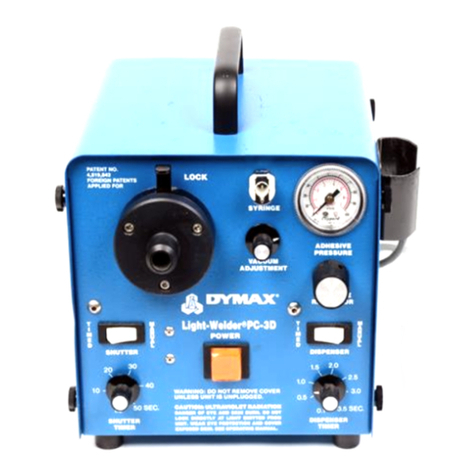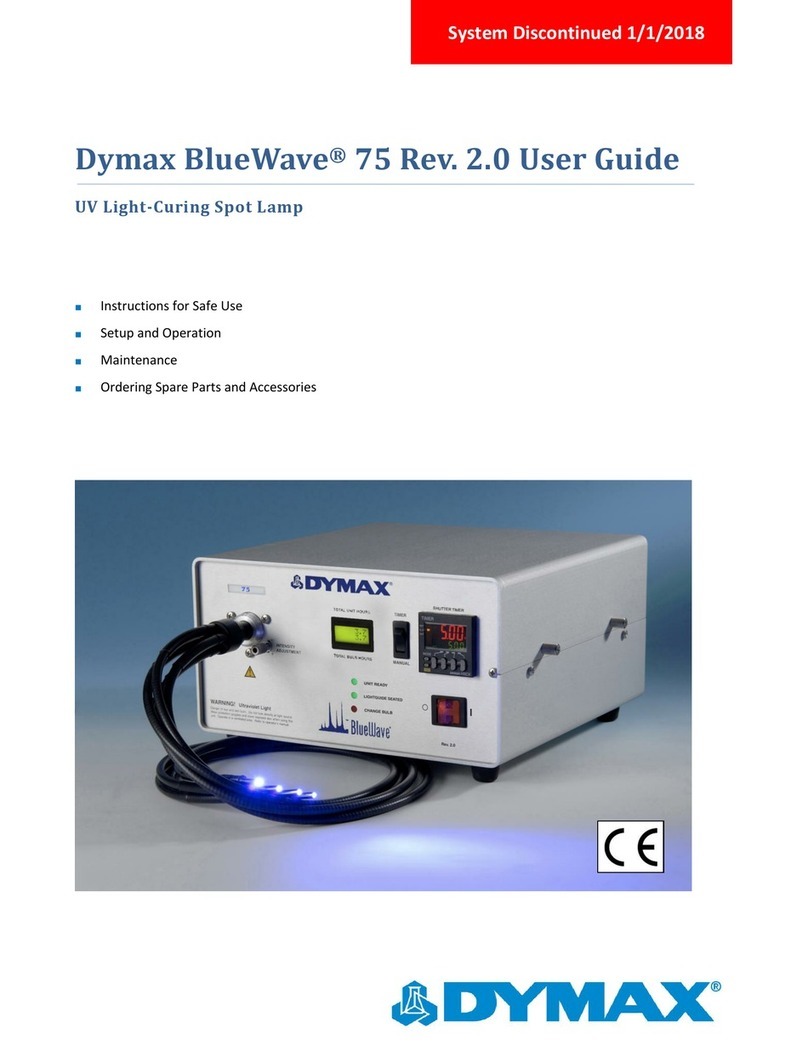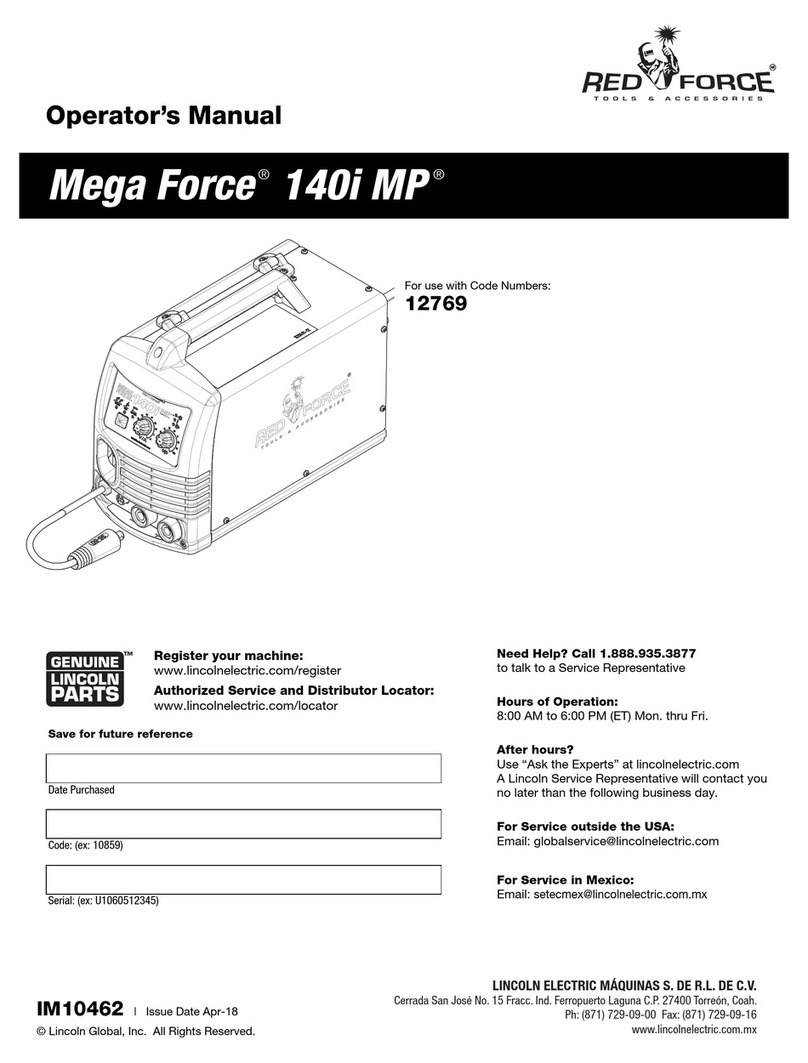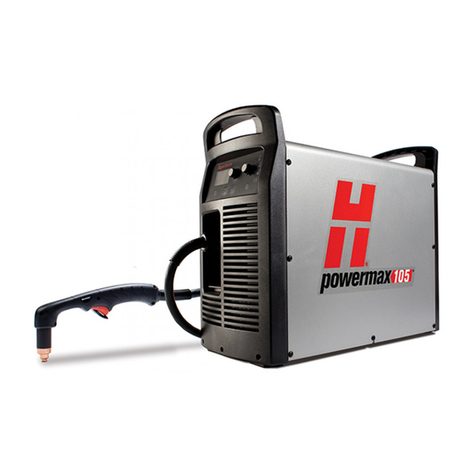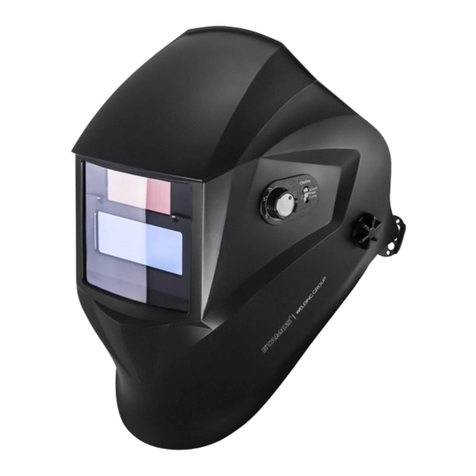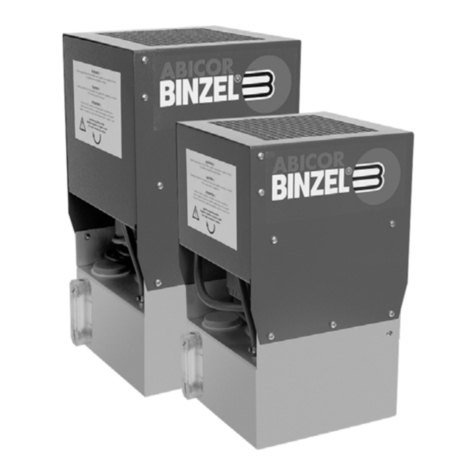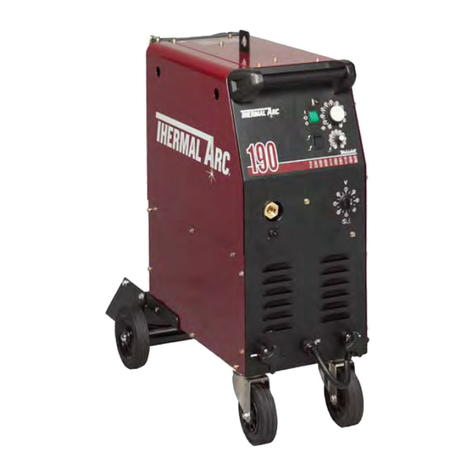dymax BlueWave LED VisiCure 41062 User manual

BlueWave®LED VisiCure®User Guide
LED Spot-Curing System
■Instructions for Safe Use
■Setup and Operation
■Maintenance
■Ordering Spare Parts and Accessories

2
Dymax BlueWave® LED VisiCure® User Guide
About Dymax
UV/Visible light-curable adhesives. Systems for light curing, fluid dispensing, and fluid packaging.
Dymax manufactures industrial adhesives, light-curable adhesives, epoxy resins, cyanoacrylates, and activator-cured adhesives.
We also manufacture a complete line of manual fluid dispensing systems, automatic fluid dispensing systems, and light-curing
systems. Light-curing systems include LED light sources, spot, flood, and conveyor systems designed for compatibility and high
performance with Dymax adhesives.
Dymax adhesives and light-curing systems optimize the speed of automated assembly, allow for 100% in-line inspection, and
increase throughput. System designs enable stand-alone configuration or integration into your existing assembly line.
Please note that most dispensing and curing system applications are unique. Dymax does not warrant the fitness of the product for
the intended application. Any warranty applicable to the product, its application, and use is strictly limited to that contained in the
Dymax standard Conditions of Sale. Dymax recommends that any intended application be evaluated and tested by the user to ensure
that desired performance criteria are satisfied. Dymax is willing to assist users in their performance testing and evaluation by offering
equipment trial rental and leasing programs to assist in such testing and evaluations. Data sheets are available for valve controllers
or pressure pots upon request.

3
Dymax BlueWave® LED VisiCure® User Guide
Contents
Introduction............................................................................................................................................. 4
Introduction to the User Guide ............................................................................................................................... 4
Where to Get Help .................................................................................................................................................. 4
Safety....................................................................................................................................................... 4
Safety Symbol Index ................................................................................................................................................ 5
Dymax Light-Curing System Safety Considerations ................................................................................................. 5
Product Overview .................................................................................................................................... 7
Description of the BlueWave LED VisiCure .............................................................................................................. 7
Intensity Control Feature ........................................................................................................................................ 7
Validation ................................................................................................................................................................ 8
Assembly and Setup................................................................................................................................. 8
Unpacking and Inspecting Your Shipment............................................................................................................... 8
Parts Included in the BlueWave LED VisiCure Spot Lamp System ........................................................................... 9
Installation & System Interconnect ....................................................................................................................... 10
Operation .............................................................................................................................................. 12
9-Pin Connector I/O Signals ................................................................................................................... 13
Input Signals .......................................................................................................................................................... 13
Output Signals ....................................................................................................................................................... 14
Cleaning and Maintenance .................................................................................................................... 15
Lightguide.............................................................................................................................................................. 15
Fan Filter................................................................................................................................................................ 16
Fuse Replacement ................................................................................................................................................. 16
Troubleshooting..................................................................................................................................... 17
Frequently Asked Questions .................................................................................................................. 18
Spare Parts and Accessories................................................................................................................... 19
Options/Accessories.............................................................................................................................................. 19
Spare/Replacement Parts...................................................................................................................................... 19
Specifications......................................................................................................................................... 20
Specifications......................................................................................................................................................... 20
Warranty ............................................................................................................................................... 22
Index...................................................................................................................................................... 23

4
Dymax BlueWave® LED VisiCure® User Guide
Introduction
Introduction to the User Guide
This guide describes how to assemble, use, and maintain the BlueWave® LED VisiCure® spot-curing system
safely and efficiently.
Intended Audience
Dymax prepared this user guide for experienced process engineers, technicians, and manufacturing
personnel. If you are new to UV light curing and do not understand the instructions, contact Dymax
Application Engineering to answer your questions before using the equipment.
Where to Get Help
Customer Support and Applications Engineering teams are available by phone and email in Germany,
Monday through Friday, from 8:00 a.m. to 5:00 p.m. Central European Time. You can also email Dymax
Europe GmbH at info_de@dymax.com. Please see the back cover for worldwide contact information.
Additional resources are available to ensure a trouble-free experience with our products:
Detailed product information on www.dymax.com
Dymax adhesive Product Data Sheets (PDS) on our website
Material Safety Data Sheets (MSDS) provided with shipments of Dymax adhesives
Safety
Before continuing with the installation, please read the following chapters of this manual for safety
recommendations and installation, operation, and troubleshooting instructions.
CAUTION! Always wear protective goggles or face shield when working near the front of
the unit, which emits high-intensity visible light!
WARNING! Always observe safety requirements!
CAUTION! Risk of electrical shock if cover is removed!
To use a BlueWave LED VisiCure system safely, it must be set up and operated in accordance with the
instructions given by Dymax. Using the system in any other manner will impair the protection of the
system. Dymax assumes no liability for any changes that may impair the protection of the BlueWave LED
VisiCure system.

5
Dymax BlueWave® LED VisiCure® User Guide
Safety Recommendations
■Use the goggles provided or an approved face shield for eye/face protection.
■Long-sleeved shirts or a lab coat are recommended for arm protection. The use of opaque gloves will
protect the hands.
NOTE: The BlueWave LED VisiCure emits high-intensity light. Never look directly at the light-emitting end
of the lightguide while the unit power is on.
Safety Symbol Index
The following symbols are displayed on the curing system. Please see below for their meanings.
Refer to Manual
Warning!
Eye Protection Required
Warning! UV Light Hazard
Dymax Light-Curing System Safety Considerations
Dymax light-curing technology has been used successfully for over 30 years. The fast cure, one-
component nature of our curing technology has made it the process of choice for many manufacturers
requiring a “Cure on Demand” assembly process. There are four common questions/concerns related to
light-curing systems: UV exposure, high-temperature surfaces, ozone, and bright, visible light.
NOTE: The energy emitted from the Dymax BlueWave LED VisiCure spot-curing system is in the Visible
portion of the spectrum. To ensure that all safety aspects regarding operations of this equipment are
addressed, please review and follow information and safety information listed below.
Light Exposure
Figure 1. Light Spectrum
Standard Dymax VisiCure systems have been designed to primarily emit visible light (as shown in Figure 1).
Although OSHA does not currently regulate visible or ultraviolet-light exposure in the workplace, the
American Conference of Governmental Industrial Hygienists (ACGIH) does recommend Threshold Limit
Values (TLV’s) for ultraviolet light. The strictest interpretation of the TLV (over the UVA range) for
workers’ eyes and skin is 1 mW/cm2(intensity), continuous exposure. Unless workers are placing bare
hands into the curing area, it is unusual to exceed these limits. To put the 1 mW/cm2limit into

6
Dymax BlueWave® LED VisiCure® User Guide
perspective, cloudless summer days in Connecticut regularly exceed 3 mW/cm2of UVA light, which
includes the more dangerous UVB light, primarily responsible for sun tans, sun burns, and skin cancer.
Checking the Workstation
A radiometer should be used to measure stray light to confirm the safety of a visible light-curing process.
A workstation that continuously exposes an operator to more than 1 mW/cm2of UVA light should be
redesigned.
Protecting Operators
Light-curing technology can be a regulatory compliant, "worker-friendly" manufacturing process when the
proper safety equipment and operator training is utilized. There are two ways to protect operators from
visible light exposure: shield the operator and/or shield the source.
Shield the Operator
Tinted eyewear will shield the operator from high intensity visible energy, and reduce eye fatigue.
Shield the Source of the Light
Any substrate that blocks Visible light can be used as a shield to protect workers from stray light. The
following materials can be used to create simple shielding structures:
Sheet Metal –Aluminum, steel, stainless steel, etc. Sheet metal should be coated black or black anodized
to minimize reflection of UV and visible light toward operators.
Rigid Plastic Film –Transparent or translucent/light-blocking plastics (typically polycarbonate or acrylic)
are commonly used to create shielding where some level of transparency is also desired.
Flexible Film –Translucent light-blocking, flexible urethane films can be used to quickly create
workstation shielding. This light-blocking, flexible urethane film is available from Dymax. Call for
assistance.
High-Temperature Surfaces
Surfaces exposed to high-intensity curing lights will rise in temperature. The intensity, distance, exposure
time, cooling fans, and the type/color of the surface can all affect the actual rise in surface temperature.
In some cases, exposed surfaces can reach temperatures capable of producing a burn or causing damage
to a substrate. In these cases, care must be taken to ensure either a more moderate surface temperature
or appropriate protection/training for operators. No infrared radiation is produced by these LED systems,
so surface temperatures will be lower than with conventional lamp systems. Empirical testing should be
used to verify the exact temperature rise in each application.
Ozone
The Dymax BlueWave LED VisiCure does not generate UVB or UVC, therefore no ozone is generated while
operating this equipment.
Bright, Visible Light
The bright, visible light energy emitted by curing systems can cause eye strain if proper eye protection or
shielding is not used. The proper use of tinted eye protection and/or opaque/tinted shielding can be
utilized to reduce eye strain and address this concern.

7
Dymax BlueWave® LED VisiCure® User Guide
Summary
Light sources can be more “worker friendly” than many commonly accepted industrial processes, provided
the potential concerns are addressed. Both the lower working temperature and lack of spurious frequency
transmission that this system produces make it even more user friendly. Contact your Dymax
representative for information regarding the proper use of Dymax curing systems.
Product Overview
Description of the BlueWave LED VisiCure
The BlueWave LED VisiCure is a light-curing spot lamp that generates curing energy using high-intensity
Light Emitting Diodes (LEDs). The relatively narrow frequency band produced by LEDs generates cooler
curing temperatures and makes the BlueWave LED VisiCure an excellent choice for spot curing various
coatings and adhesive bonding of polycarbonate, PVC, PET, metal, glass, and many other substrates. LED
light-curing systems offer many advantages over conventional spot-curing systems including no bulbs to
change, cooler cures, no warm-up, and constant intensity for thousands of hours. The BlueWave LED
VisiCure is rated for continuous operation and can run in either timed or manual operating modes. The
power supply operates on line voltages of 100 to 240 VAC, 50/60 Hz.
The BlueWave LED VisiCure unit is comprised of an anodized aluminum housing which contains an
electronic power supply, circuit protection, an LED assembly, cooling fans, a lightguide mount, a lightguide
safety interlock, and a control PCB with connections for a remote operation system. Cooling fans are
provided to keep the housing and internal components of the unit at the optimum operating temperature.
The fan filter should be changed or cleaned frequently to prevent blockage and reduced ventilation
airflow. The air vents must not be covered or otherwise blocked. A thermal shutdown sensor is provided
for internal temperature control of the unit.
The unit’s curing energy is emitted from a lightguide. This guide can be hand-held for complete mobility,
positioned into a fixture for repetitive operations, or mounted to automated equipment. The lightguide is
separate from the unit and plugs into the lightguide mount on the front panel of the unit.
WARNING! Insert the lightguide into the lightguide mount before the light is turned on, and remove
the lightguide ONLY AFTER the light is turned off. To secure the lightguide, lightly tighten the set screw
(located on the top of the lightguide mount) after the lightguide is inserted. If the lightguide is removed at
any time during an exposure cycle, the power is removed from the LED immediately. Replacing the
lightguide will automatically re-energize the LED.
The unit also features an intensity control on the front panel, which allows operators to adjust the output
intensity during process validation and production. Users can adjust and maintain the output intensity
level from 0 - 100% to meet their process curing parameters.
Intensity Control Feature
The components used in all curing systems degrade with use. Intensity, therefore, decreases as the
system ages. The BlueWave LED VisiCure intensity control allows for compensation to address this slow
degradation. Users can eliminate this variation by manually increasing output intensity to offset this
degradation. The intensity can be adjusted with a tool, as shown in Figure 2. The intensity adjustment is a
10-turn potentiometer and allows fine control of output intensity. This feature is useful for both
validation and control.

8
Dymax BlueWave® LED VisiCure® User Guide
Figure 2. Intensity Adjustment
Validation
Tests should be conducted prior to production to determine the time and light intensity required to fully
cure your light-curable material in your specific application. The following approaches may be used to
validate the curing process.
Set Exposure Time, Determine Intensity
Users can specify a cure time and, through empirical testing, determine the intensity required to achieve a
full cure. As with any manufacturing process, it is advisable to incorporate a safety factor.
Set Intensity, Determine Exposure Time
Users can specify light intensity and, through empirical testing, determine the exposure time required to
achieve a full cure. As with any manufacturing process, it is advisable to incorporate a safety factor.
Control
Process validation confirms a minimum acceptable intensity. Users can then choose to operate at a higher
available intensity level (using the additional intensity as a cure safety factor) or adjust the output to a
specific intensity level. To ensure consistent and repeatable process results, it is advisable to monitor
intensity levels with the use of a radiometer. This allows identification of any potential maintenance
requirements or intensity adjustment necessary.
Assembly and Setup
Unpacking and Inspecting Your Shipment
Your BlueWave LED VisiCure arrived in one or two boxes. Inspect the boxes for damage and notify the
shipper of box damage immediately.
Open each box and check for equipment damage. If parts are damaged, notify the shipper and submit a
claim for the damaged parts. Contact Dymax so that new parts can be shipped to you immediately.

9
Dymax BlueWave® LED VisiCure® User Guide
Check that the parts included in your order match those listed below. If parts are missing, contact your
local Dymax representative or Dymax Customer Support to resolve the problem.
Parts Included in the BlueWave LED VisiCure Spot Lamp System
■BlueWave LED VisiCure –Part Number Dependent on Power Cord Ordered (1)
■Footswitch PN 40402 (2)
■UV Protection Goggles PN 35285 (3)
■2-mm Hex Wrench PN 38656 (4)
■Flat Blade Screwdriver PN 39695 (5)
■BlueWave LED VisiCure User Guide PN 41065 (6)
■Snap-In Clip PN 39667
■Filter Media PN 40008
■Power Cord (7)
Model 41062–Standard 120V North American Power Cord
Model 41063 –Type G Plug
Model 41064 –No Power Cord (Note: For European customers, the appropriate power cord will be
added)
Figure 3. BlueWave LED VisiCure Components

10
Dymax BlueWave® LED VisiCure® User Guide
Installation & System Interconnect
1. Connect the Power Cord to the rear of the unit and plug into a grounded wall outlet.
2. Connect the Footswitch to the connection in the rear of the unit.
Figure 4. Rear Panel Cable Connections
3. Install the Lightguide:
■Remove the protective cover from the unit’s Lightguide Mount.
■Remove the protective end caps from the Lightguide.
■Visually inspect the two ends of the Lightguide to verify that no foreign material is present.
NOTE: Dymax liquid-filled lightguide ends can be cleaned with isopropyl alcohol to remove foreign
material and outgassing deposits.
■Fully insert the large end of the Lightguide into the Lightguide Mount on the front panel.
NOTE: When properly seated, a light “click” may be heard and/or felt.
Figure 5. Lightguide Mount Set Screw
If desired, the Lightguide may be fastened into place by lightly tightening the Securing Set Screw in
the top of the Lightguide Mount. A Hex Wrench is provided with the unit for this purpose. The Set
Screw should be tightened gently to prevent damaging the Lightguide.

11
Dymax BlueWave® LED VisiCure® User Guide
NOTE: Multi-pole lightguides should be checked for leg-to-leg output uniformity. Rotate the
lightguide to verify the desired intensity of each leg before tightening the set screw.
■The Lightguide is now installed and ready for use. The end of the Lightguide should be periodically
cleaned with isopropyl alcohol. Adhesive build-up may be removed from the end of the Lightguide by
gently scraping using a razor blade or razor knife.
4. Turn the Power Switch to the on position.
5. There is no need for a warm-up or cool-down period with this LED system. The unit may be powered
down and powered up again immediately without causing any negative effects.
6. Activate an exposure cycle by pressing on the Footswitch. With the Timer/Manual Selector Switch
(located on the front panel of the unit) in the manual position, the exposure time is controlled directly
from the Footswitch. In the timed position, operation is determined by the setting displayed on the
electronic timer. Simply push the timer setting buttons to enter the desired number of seconds the
LED needs to be powered.
7. With the system exposure active, adjust the Intensity Adjustment Screw as required to achieve the
desired output intensity on an appropriate radiometer. The Intensity Adjustment Screw is a 10- turn
potentiometer.
Figure 6. Intensity Adjustment Screw

12
Dymax BlueWave® LED VisiCure® User Guide
Operation
The BlueWave LED VisiCure will arrive almost fully assembled. Please refer to the installation section of
this manual for installation of the lightguide, power cord, and footswitch. The system should be
positioned in a dry location that does not obstruct airflow around the unit.
IMPORTANT: To ensure that exposure output of the system is obtained, be sure that the lightguide is
fully inserted and seated into the entrance fitting prior to tightening the set screw. Be sure to lightly
tighten the set screw to ensure the lightguide remains in place during use.
To energize the system, turn the main power switch from the “O” position to the “l” position; the power
supply and timer should begin to function.
Figure 7. Main Power Switch
Figure 8. Timer
CAUTION! Always wear protective goggles or a face shield when working near UV or bright visible
light. Never look directly at the light-emitting end of a lightguide.
The timer located on the front panel of the BlueWave LED VisiCure is factory set to the most common
operating mode and recommended operation of the timer with the BlueWave LED VisiCure.
The front panel of the timer contains an LED display and keypad. The LED display has a reset indicator,
key-protect indicator, output indicator, preset value, set value, and timing operation indicator.
A brief description of each display and location:
Output Indicator –Displays OUT in upper left corner of timer display. Displayed when relay is
switched on; is not displayed when relay is switched to off.
Present Value –Four-digit segmented display in center of timer. Shows current status of time.
Set Value –Four-digit segmented display in lower right corner of timer. Shows set length of time.
Reset Indicator –Display on the left of meter face. Active when the timer is reset by pressing the
“RST” button on the lower left face of timer. Or when the rear panel PLC Safety Interlock is active.
“RST” can also be used to cancel a currently running exposure cycle
Key Protect –Located on center left side of display. Will always be lit because the timer function
is programmed at the factory and locked before shipment.

13
Dymax BlueWave® LED VisiCure® User Guide
To operate the timer, select the “TIMER” option of the Timer/Manual Selector Switch on the front panel.
In this mode, the LED will remain powered on until the timer counts down to 00.00. To program the
Timer, press the appropriate key (up or down) until the corresponding digit increments or decrements in
the set value. By pressing the up key labeled (1), it will increment the left most digit on the set value. By
pressing the up key (2), it will increment the second digit of the set value. The same will happen with the
up key (3) and the third digit of the set display, and up key (4) and the fourth digit of the set display. The
Timer will increment from 9 back to 0. The Timer comes programmed for a range of 00.01 seconds to
99.99 seconds. Consult the factory for other time ranges and function options available.
Program the time into the Timer and depress the Footswitch to activate the LED. Factory settings will
power the LED and the programed value will begin to count backward. When the Timer reaches 00.00, it
will reset to the programed value and remove power from the LED. The Timer can be stopped by pressing
the RESET button on the lower left face of the Timer. If power is removed from unit, the Timer will reset
to the programed value.
There are a few fault conditions that may shut off the LED during operation. The LED will automatically
shut off if the internal sensors reach an over-temperature condition. If an over-temperature shutdown
occurs, check that the airflow is not restricted to the system and that the fan filter is clean. If the condition
persists, consult Dymax Customer Service for further assistance. If the lightguide is not fully seated into
the unit, or if it becomes dislodged by as little as ⅛" from the Lightguide Mount, the Safety Interlock
Switch will terminate power to the LED. Re-seating the lightguide will automatically re-activate it. No user-
serviceable parts exist within the enclosure. The LED does not employ an automatic life-end shutdown
circuit.
Position the curing end of the lightguide no closer than ¼" from material being cured. Placing the
lightguide end too close can cause the lightguide to become cloudy from vapors coming off of the curing
material.
In a typical bulb-based system, lamp life is reduced each time it is started. The new LED-based systems
have no such limitations. They can be shut off and then immediately restarted with no cool-down or
warm-up periods or loss of system lifetime.
9-Pin Connector I/O Signals
The BlueWave LED VisiCure unit is equipped with a 9-pin D-subminiature connector that provides interface
between the device and a PLC or similar factory control equipment. The following describes available
inputs and outputs.
Input Signals
Each input signal is optically isolated from the internal circuit of the BlueWave LED VisiCure. A positive
+24V and maximum 10-milliamp current source is required to activate each signal input. All inputs are
returned to the common terminal, and have built-in current-limiting resistors to protect the isolators.
Pin 1 –+24V: Applying power to this pin enables the Safety Interlock (4). The safety interlock will not
function unless +24V is applied to this pin.
Pin 2 –Common: All signals, both inputs and outputs, are returned to this pin. Common may be used
independently of +24V for all outputs and inputs, except for the safety interlock (4) input.

14
Dymax BlueWave® LED VisiCure® User Guide
Pin 3 –Shutter In: This signal line may be used to remotely activate the BlueWave LED VisiCure. When it
is being used, the local footswitch on the rear of the BlueWave LED VisiCure box is still capable of
operating the unit. Similar to the footswitch, if the timer/manual selector switch is in Timer Mode, the unit
will power the LED for the time set on the timer. In the Manual Mode, the unit will power the LED for the
duration of the remote activate signal.
Pin 4 –Safety Interlock In: A safety interlock can be connected between Pins 1 and 4. While +24V is
applied to Pin 4, the system will allow activation of the LED. If the connection is broken, power is
immediately removed from the LED. The safety interlock relies on the +24V signal being present on Pin 1.
In addition to removing power from the LED, if the system is being operated in the TIMED mode, breaking
this connection will reset the timer to zero. A second “shutter” signal will reactivate the LED for the timed
duration.
Pin 5 –Intensity In (PWM): This input is supplied as a means to actively control the output intensity of
the BlueWave LED VisiCure unit. It can be used to Pulse Width Modulate (PWM) the power to the LED.
This input cannot increase the intensity over the set point of the front panel intensity adjustment, but can
only reduce it. The front panel adjustment should be set fully clockwise to give Pin 5 the greatest range.
A high level (+24V) on Pin 5 will turn off the LED and a low level (0V) will allow maximum LED intensity. A
signal of 1.K Hz should be used with a duty cycle of 0 to 60%.
NOTE: A 10% duty cycle will generate a greater intensity than a 50% duty cycle.
This input can be used with an external controller to create any number of customized step-cure profiles
or with an additional sensor to regulate the output.
Output Signals
The output signals are all opto-isolated signals. Each signal has an NPN output transistor. The emitters of
all output transistors are tied together and connected to the PLC common on DB9 Pin 2. Each individual
output signal line is connected to the collector of each transistor. When the transistor is turned on, this
provides a ground to the PLC system that can be used to enable a relay coil signal to an opto-coupler. The
conducting transistor can also function as a set of contacts that can initiate actions within the PLC. When
the transistor is on, the signal is said to be “enabled” or “asserted”. When the transistor is off, the signal is
said to be “disabled” or “unasserted”. The transistors have a max current rating of 30 mA, and a max
power rating of
150 mW. Only positive voltages with respect to the PLC common should be used to a maximum of 24 Volts
DC. Series-limiting resistors should be used to ensure that the max conditions are not exceeded.
Pin 6 –Lightguide Engaged Out: When a lightguide is fully inserted into the unit, an internal switch will
allow the LED to operate. The same switch will send a signal to turn on the transistor and connect Pin 6 to
Pin 2. This output can be used to verify the condition of the system, should an error occur, or alert a user
to the failure.
Pin 7 –LED Powered Out: Pin 7 will be shorted to Pin 2 when the LED power supply is powered up and
the set point is above a predetermined level. Pin 7 will be open with respect to Pin 2, if the LED power
supply is off for any reason. This output can be used as go/no go confirmation that the array power supply
is engaged. Note: Verification of LED illumination should be made visually to ensure proper operation.
Pin 8 –Intensity Out (PWM): An internal circuit monitors the current sent to the LED, and generates a
PWM signal whose frequency and duty cycle varies with the current. Adjusting the front panel Intensity
Adjustment Screw, or using the Intensity Input on Pin 5, will cause a change in the signal seen on Pin 8.

15
Dymax BlueWave® LED VisiCure® User Guide
This output can be used to verify step or ramped changes in the intensity for customized profiles, or to
alert the remote controller when the system has reached maximum intensity in a closed-loop system.
Pin 9 –Over Temp Out: A sensor constantly monitors the temperature of the LED in the system. If, for
any reason, the reading rises above a predetermined limit, the control PCB will shut off current to the LED
to prevent damage. When the measured temperature drops to a lower threshold, the PCB will re-enable
current to the LED.
NOTE: If this fault occurs, check for proper airflow into and out of the unit. Also verify that the air filter is
clean.
Figure 9. 9-Pin D Connector I/O Signals
Cleaning and Maintenance
The BlueWave LED VisiCure was designed to operate with minimum maintenance. Follow the schedule
below to assure top unit performance.
Lightguide
Clean the lightguide ends monthly or as required. The ends of the lightguide should be kept clean to
transmit as much light as possible. Cured adhesive can be carefully removed from liquid-filled lightguide
ends with a razor blade. Avoid sharp bends with the lightguide since this reduces light output and
permanently damages the guide.

16
Dymax BlueWave® LED VisiCure® User Guide
Fan Filter
The external fan filter should be inspected and cleaned periodically to prevent dust buildup from affecting
airflow through the unit. Spare filters are provided with each unit. The fan filters are washable and may
be reused. Remove the fan filter by removing the snap-on cover from the rear of the fan.
Figure 10. Cooling Fan Filter & Cover
Fuse Replacement
The unit is supplied with two Fuses that are installed in the Power Receptacle. To remove the Fuses,
unplug the unit and remove the Fuse Holder with a small screwdriver. Remove the Fuses from the Fuse
Holder and install new Fuses. Replace the Fuses with 2.0 Amp fast-blow types (Dymax PN 37236 or
equivalent). Reinstall the Fuse Holder into the Power Receptacle.
Figure 11. Power Receptacle
Figure 12. Fuse Holder
Figure 13. Fuses (PN
37236)

17
Dymax BlueWave® LED VisiCure® User Guide
Troubleshooting
WARNING: Only qualified maintenance personnel should attempt the following procedures.
Table 1. Troubleshooting Chart for BlueWave LED VisiCure
Problem
Possible Cause
Testing
Corrective Action
The unit’s LED
will not
illuminate
There is an incorrect
connection
Visually inspect all
input/output connections (i.e.
power cord, foot switch,
lightguide).
Secure all connections.
The main line fuse is
blown (nothing in unit
operates)
Remove the fuse from the
power receptacle and check it
with an ohmmeter.
Replace the fuse if
defective.
The lightguide is not
fully inserted
Remove the lightguide.
Re-insert the lightguide
into the lightguide mount.
The unit has
low output
intensity
or
The unit fails to
cure the
material in the
allotted time
The intensity adjustment
is set too low
Use a radiometer (Dymax
ACCU-CAL 50-LED) to measure
the output intensity.
Adjust the setpoint to the
desired intensity.
The transmission loss in
the lightguide is too
great
Compare the lightguide output
against a new lightguide or use
a Dymax lightguide simulator to
determine the transmission
loss.
Replace the lightguide.
There are contaminants
on the lightguide
Visually examine ends of
lightguide for contaminants.
Clean the lightguide ends
with isopropyl alcohol or
an equivalent. Heavy
deposits on liquid
lightguides may be
carefully removed using a
razor blade. Replace the
lightguide if it cannot be
cleaned.
The system has
inadequate cooling
Check the air filter for debris
and blockages at the exit vents.
Clean or replace the filter.
Remove all air blockages
from around the unit.
The footswitch
is not
operating
There is an incorrect
connection
Check the connection of the
footswitch into the unit.
Re-insert the footswitch
into the unit.

18
Dymax BlueWave® LED VisiCure® User Guide
Frequently Asked Questions
Q.) My BlueWave LED VisiCure will not turn on.
A. Check the power cord connection.
B. Check the fuses located where the power cord plugs into the unit.
Q.) The LED will not light, but the unit is powered up.
A. Check that the lightguide is fully seated in the lightguide mount.
B. Confirm that the intensity adjustment is not at the minimum setting.
C. Check the condition of the signals on the DB9 connector (+24V, Safety Interlock, and Intensity Input)
Q.) I have low intensity.
A. The end of the lightguide may have a build-up of adhesive. Carefully remove any build-up with
isopropyl alcohol or for heavier deposits gently scrape it with a razor blade.
B. The condition of the lightguide can also affect the intensity. All lightguides degrade with time, but
intensity will also drop if the lightguide is bent or compressed. The intensity reading from the
lightguide should be compared to the intensity reading from a lightguide simulator to determine
the efficiency.
C. The intensity adjustment is set incorrectly. Turn the knob fully clockwise for the maximum intensity
out.
D. The connections or signals applied to the DB9 connector are incorrect. Verify that the safety and
intensity input lines are not shutting down current to the LED.
Q.) Why does my BlueWave LED VisiCure unit seem to run very hot?
A. Replace the fan filter media on the intake fan (located on the back panel). This is your first line of
defense against airborne dust and debris. This filter media and several spares are supplied with new
units and should be changed regularly.
B. Ideal operation of this equipment suggests at least 6 inches of clearance around the unit for proper
ventilation. Also confirm that the intake fan is not feeding from the exhaust of other equipment.
C. Confirm that the fan is operating.
D. Your equipment may already be full of dust and debris, causing over heating of the unit’s internal
electronics.
NOTE: The internal fans do not activate until required. If the setting of the intensity output is low or
if the ambient air temperature is lower than normal, the fans may not be active or they may take
longer than usual to engage.

19
Dymax BlueWave® LED VisiCure® User Guide
Spare Parts and Accessories
Options/Accessories
Item
Part Number
Personal Protection Equipment
Protective Goggles —Green
35286
Protective Goggles —Gray (standard model included with unit)
35285
Face Shield
35186
Radiometer
Dymax ACCU-CAL™ 50-LED Radiometer (spot)
40505
Lightguides
Lightguide Simulator, 5 mm
38408
Liquid-D Lightguide, 5 mm x 1 M
5720
Liquid-D Lightguide, 5 mm x 1.5 M
5721
Liquid-D Lightguide, 8 mm x 1 M
5722
Miscellaneous
Carry Case with Foam Inserts
1-40009
1-40010
2-40011
1-40012
Spare/Replacement Parts
Item
Part Number
Fuses
Fuses: F2.0 amp
37236
Fan
Fan
40034
Fan Assembly
40004
Fan Filter and Holder
40460
Fan Filter Media
40008
Footswitch and AC Power Cords
Footswitch
40402
Power Cord, North American
35255
Power Cord, China Type G Plug
40542
Tools & Hardware
2 mm Hex Wrench
38656
Flat Blade Screwdriver
39695
Miscellaneous
Rubber Feet
5039

20
Dymax BlueWave® LED VisiCure® User Guide
Specifications
Specifications
Property
Specification
Part Numbers
41062
North American Version (standard 120V plug)
41063
Asian Version (Type G plug)
41064*
Unit without a power cord
Intensity Output
Total†
(280-450 nm)
16.8 W/cm2typical
Visible‡
(400-450 nm)
15.0 W/cm2typical
UVA‡
(320-395 nm)
0.233 W/cm2typical
UVB‡
(280-320 nm)
0 mW/cm2typical
Power Requirements
100-240 V, 50/60 Hz, <100 Watts
Power Supply
Solid state, 100 Watt
Temperature/Humidity
40°C maximum/non-condensing
Timer
Digital timer up to 99.99 seconds; manual or timed exposure
Activation
Footswitch or PLC
I/O Port
9-Pin D –sub-miniature connector
Signals
(PLC Integration)
Inputs: +24VDC, activate, safety interlock, output adjust
Outputs: LED lit, lightguide inserted, output setpoint, over temperature
Cooling
Filtered fan arrangement
Housing Dimensions
5.4" x 8.5" x 8.8" [13.7 cm x 21.6 cm x 22.3 cm]
Weight
5.40 lbs. (2.45 kg)
Unit Warranty
1 year from purchase date
Certifications
CE marked
* Contains the appropriate power cord for Europe
†Measured with an ACCU-CAL™ 50-LED radiometer attached at the end of a Lightguide Simulator
‡Measured with a UV Power Puck® II at the end of a Lightguide Simulator
Figure 14. BlueWave LED VisiCure Spectral Output
This manual suits for next models
2
Table of contents
Other dymax Welding System manuals
Popular Welding System manuals by other brands

Simder
Simder MIG 140 operating manual
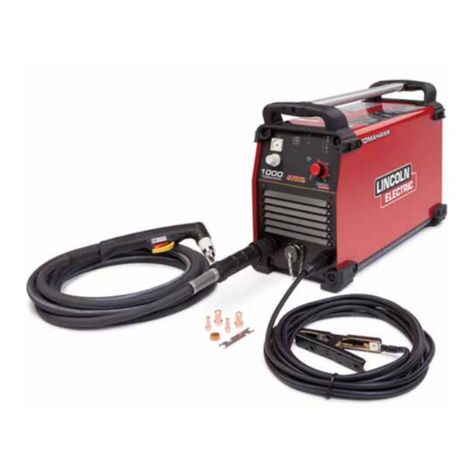
Tomahawk
Tomahawk 1000 Operator's manual

Lincoln Electric
Lincoln Electric PRO-CUT 10474 Operator's manual
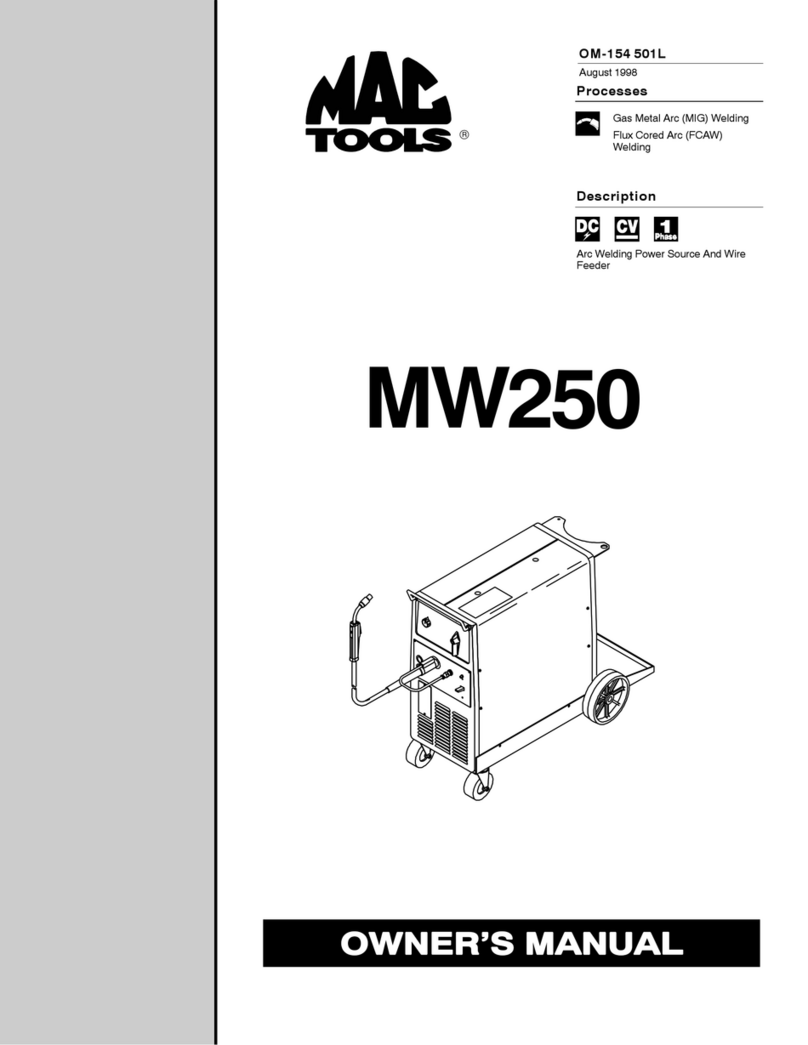
MAC TOOLS
MAC TOOLS MW50 owner's manual

Telwin
Telwin TECNICA 1400 Troubleshooting and repair manual

Campbell Hausfeld
Campbell Hausfeld WG3000 Operating instructions & parts manual
